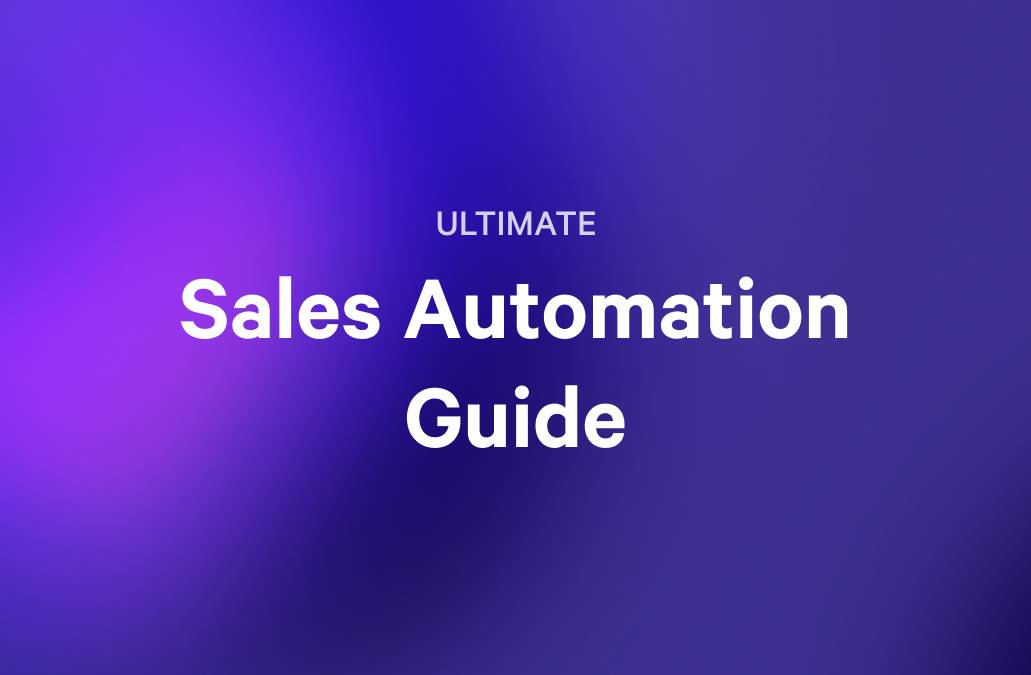The Software-as-a-Service industry offers massive growth opportunities for founders, operators, and sales leaders. However, the success of the company is often highly dependent upon whether leaders are able to deploy an effective sales strategy, and whether they can maintain alignment around their go-to-market (GTM) plan alongside product, marketing, customer success, and customer support.
In this article, we'll help you navigate through these complexities and craft a SaaS sales strategy that maximizes your growth potential in the B2B space.
But, first...
What exactly is a SaaS sales strategy?
A SaaS sales strategy is a master plan that outlines how you'll acquire, grow and retain customers.
A robust SaaS sales strategy employs a mix of marketing and sales programs, often including some combination of inbound marketing, outbound, and channel partnerships.
An effective SaaS sales strategy ensures not only the delivery of value to your customers, but also the building of strong customer relationships and the fostering of customer loyalty.
Crafting Your SaaS Strategy
To create a sales strategy that addresses the needs and expectations of your customers, it’s important that you accomplish the following:
1. Choose Your SaaS Sales Model
Your SaaS sales model is determined by what you're selling and who you're selling it to. In SaaS, there are three main selling models to choose from:
a. Customer Self-Service Model
This selling model is ideal for low-price products and high-volume sales. Many well-known B2B SaaS solutions fall into this category, such as Mailchimp, Figma, and Lavender.
Customers are encouraged to sign up through onboarding processes that rely on automation, typically with little direct involvement from sales reps, customer success or through support from CCaaS providers, until later qualified to be a larger opportunity. These businesses often create demand in-market with a 'freemium' offering that allows them to reach a broader set of prospects that can ‘try before they buy’.
A key enabler of this model is customer self-service portal software, which allows customers to manage their own accounts, access resources, and resolve issues independently.
b. Transactional Sales Model
For software products with a higher price point and more extensive features, the transactional sales model is often used, targeting small to medium-sized businesses and mid-market companies. This model adds personalized service and a tailored approach to each customer's unique needs.
Sales representatives in the transactional model work proactively to establish strong relationships with customers. They engage in detailed conversations to understand their clients' pain points and requirements, offering customized solutions, deals, and discounts where appropriate. This relationship-building process ensures that the product and its pricing align with the value provided to the customer.
Examples of SaaS companies using the transactional sales model include HubSpot and Asana. These example companies serve a diverse range of businesses, requiring a flexible sales approach that caters to each client's specific needs and expectations.
c. Enterprise Sales Model
Reserved for high-ticket software products, this selling model targets large enterprises often with fewer deals in the sales pipeline at a single point in time.
The enterprise sales model often relies on value-based pricing, where the product's price reflects the solution's value to the customer, and is untethered from hard costs like development or operational costs. This model requires extensive relationship building, a multi-threaded sales approach with multiple stakeholders and decision-makers with varied needs, and often product requests – extending the SaaS sales cycle out to 6 months or longer.
Well-known examples of companies employing this selling model include Salesforce, Gong.io and ServiceNow. Each of these companies caters to large organizations with complex sales needs, making the enterprise SaaS sales model the obvious choice for their offerings.
Here's a quick visual summary table:
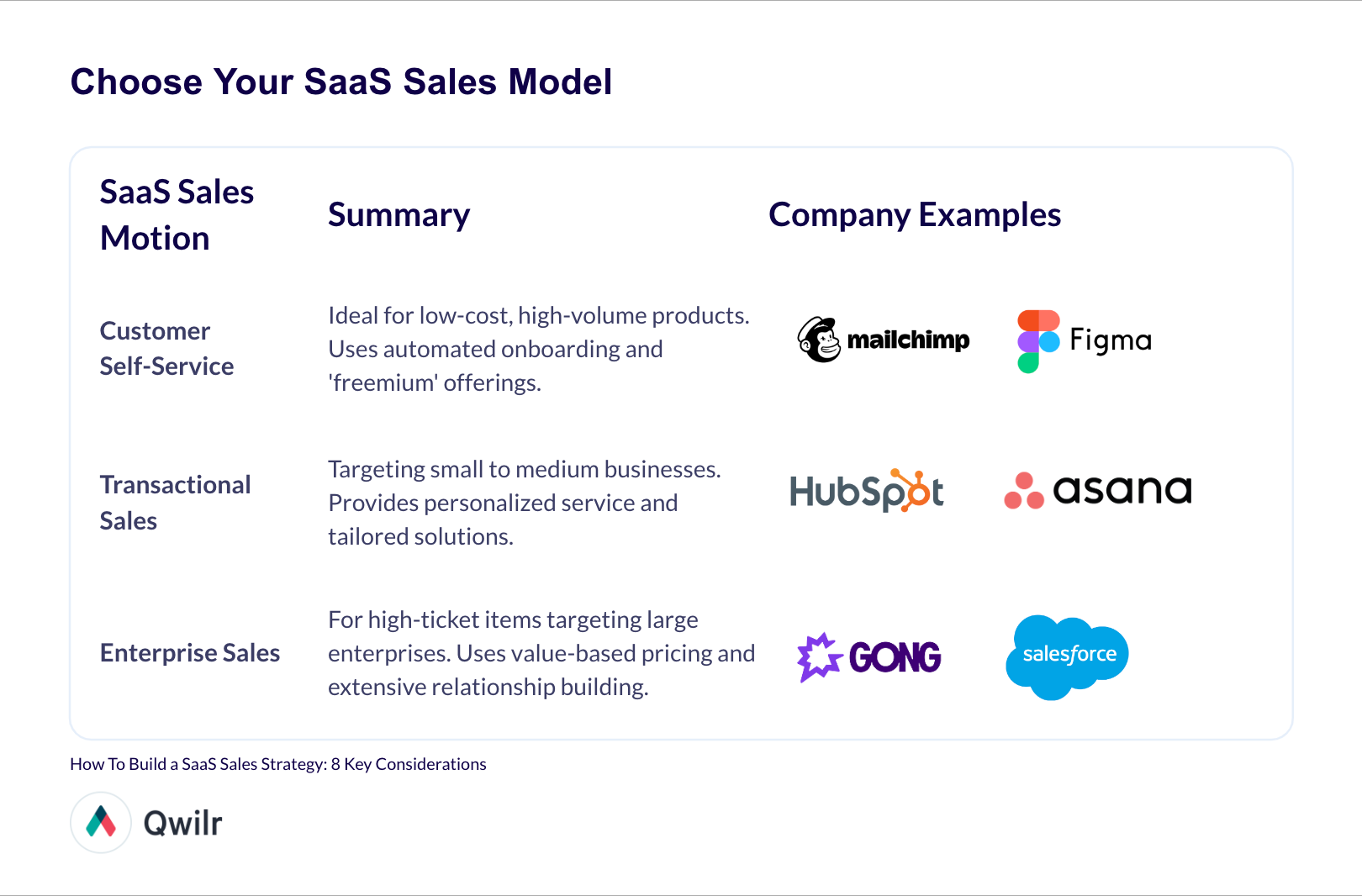
2. Identify Your USP and Your Customer Avatar
Once you’ve established which sales model (or blend of sales models) aligns most closely with your GTM plan, the next elements of your saas sales plan to establish are your unique selling proposition (USP) and customer avatars.
A good USP aims to solve a problem or business pain point in a way other solutions can’t. Creating a strong USP involves answering the following three questions:
- What genuine problem does your product solve? Providing an effective solution for a clear market need is a non-negotiable requirement for any B2B SaaS product. Companies that fail to do so risk joining the 35% of startups that fail for this reason.
- How is your product the best solution for your target audience? Understanding the specific needs of your target audience will also help you design your customer avatar.
- What’s the most effective way to communicate the benefits of your product? Your USP should prove that you know who you’re talking to, and should be embedded in all your communications, from sales scripts through to website copy.
Developing the most detailed picture possible of your ideal customer and their requirements will provide much of the critical information required to craft a successful USP (as well as inform your marketing and sales process and help optimize your sales funnel).
For well-established businesses, drawing on real-life examples of existing customers will provide first-hand experiences and insights for your avatar.
With cross-team input from your support, customer success and marketing teams, analyze your most successful client relationships. Look for recurring themes, pain points, and pivotal moments in the buyers sales experience. What problems did they talk about? What problems did they not talk about? And how did you solve those problems?
Even your failures can help you build an avatar. It’s important to break down and analyze your less successful customer relationships, too - these cases will help you refine your lead qualification framework.
Newer start-ups without the access to this kind of data need to rely more heavily on their market research tools to find out about their potential customers e.g. focus groups, surveys, LinkedIn, competitor analysis. For example, they can create survey forms, integrate them with a QR code using a QR code generator, and share it with their target audience
Using a sales analytics platform can help you quickly leverage data from your initial leads right from day one, providing rich, detailed insights into your existing customers to help you learn what you need to accurately create your avatar.
3. Create Your SaaS Sales Playbook
A well-defined sales model, a compelling USP and a detailed set of customer avatars will provide a solid foundation on which to build your software sales playbook.
A single centralized destination of sales content has long been an essential component of the sales process. Basic playbook essentials include;
- Email templates
- Call scripts
- Closing techniques
- Sales collateral
- Relevant content marketing assets
- Discretionary pricing guidelines
- Industry and competitor information
- Cheat sheets, containing key points to remember about customer avatars
A centralized knowledge management system is a vital component of your SaaS sales playbook. Digital playbooks are ‘deconstructed’, which allows them to be quickly aligned with complex buying journeys, providing sales representatives with instant intuitive access to whichever resource is most currently relevant.
Tools like Qwilr also track customer engagement with sales collateral, integrated with your CRM to provide analytics insights and help guide sales team decision-making.
It also provides many customizable business proposal templates, including SaaS and enterprise sales proposal templates.
We also have a guide on how to write a SaaS proposal that converts which you may find helpful.
4. Structure Your SaaS Sales Team
Every aspect of your sales process should be devised with your customer’s needs in mind, and the structure of your sales team is no different - with each team role or recurring task, you’ll need to look for ways to reduce friction for buyers.
We can use the SaaS sales models to help us find the proper mix of sales reps, account executives, and sales engineers. Within the transactional sales model, giving your sales reps more autonomy, and letting them handle cold calling and qualifying leads will allow you to run a leaner tier of account executives, who’ll be free to concentrate on client management, SaaS PPC strategies, and other higher-level functions.
Within the enterprise sales model, greater specialization is required, with a greater proportion of senior executives and sales engineers working collaboratively to manage a potentially more technical and demanding SaaS sales process.
It’s important to note that many software companies are operating a blend of sales models, with different approaches utilized for SMBs, mid-market or enterprise clients.
Your SaaS sales team structure will also be determined by the size of your company. Recognised SaaS entrepreneur and investor, David Sacks, offers sound advice on how to staff a B2B SaaS startup at every round of funding:
For a company with around 50 employees on its Series A funding round, a typical sales team comprised of 12 salespeople might look for a roughly equal distribution of account executives across enterprise, mid-market and SMB accounts (depending on need), with 2-4 sales development representatives (SDRs) working on outreach, a head of sales and one sales ops.
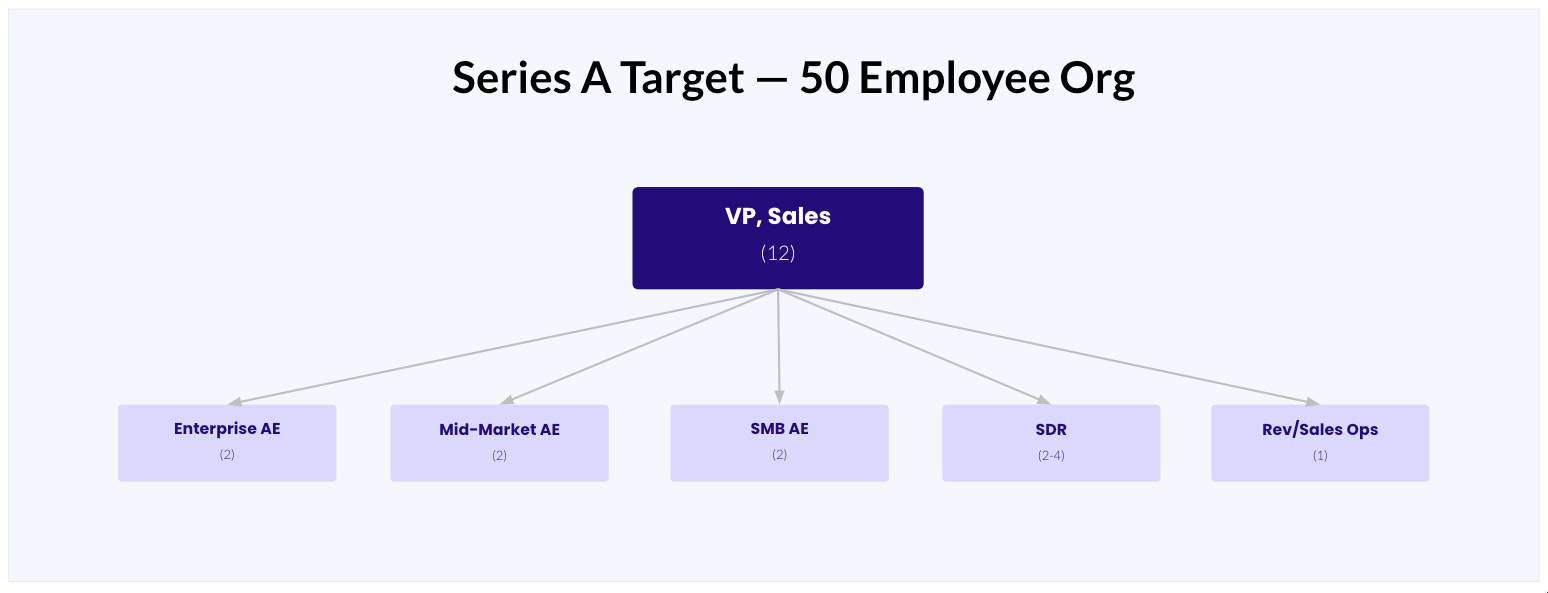
A company looking to scale up using Series B funding (with around 125 employees) would need more firmly established sales development and sales operations teams, each with its own lead. The number of account execs would be scaled up, and a renewals specialist would be worthwhile. A reasonable headcount of 20-25 sales professionals could be expected for this team.

For established larger software companies, with 400+ employees, on their Series C funding round, a team of 70 salespeople or more is common. The sales development team typically accounts for a third of the personnel, and a dedicated sales training team of five or more is essential to further growth. Use our sales growth calculator to find out your growth rate.
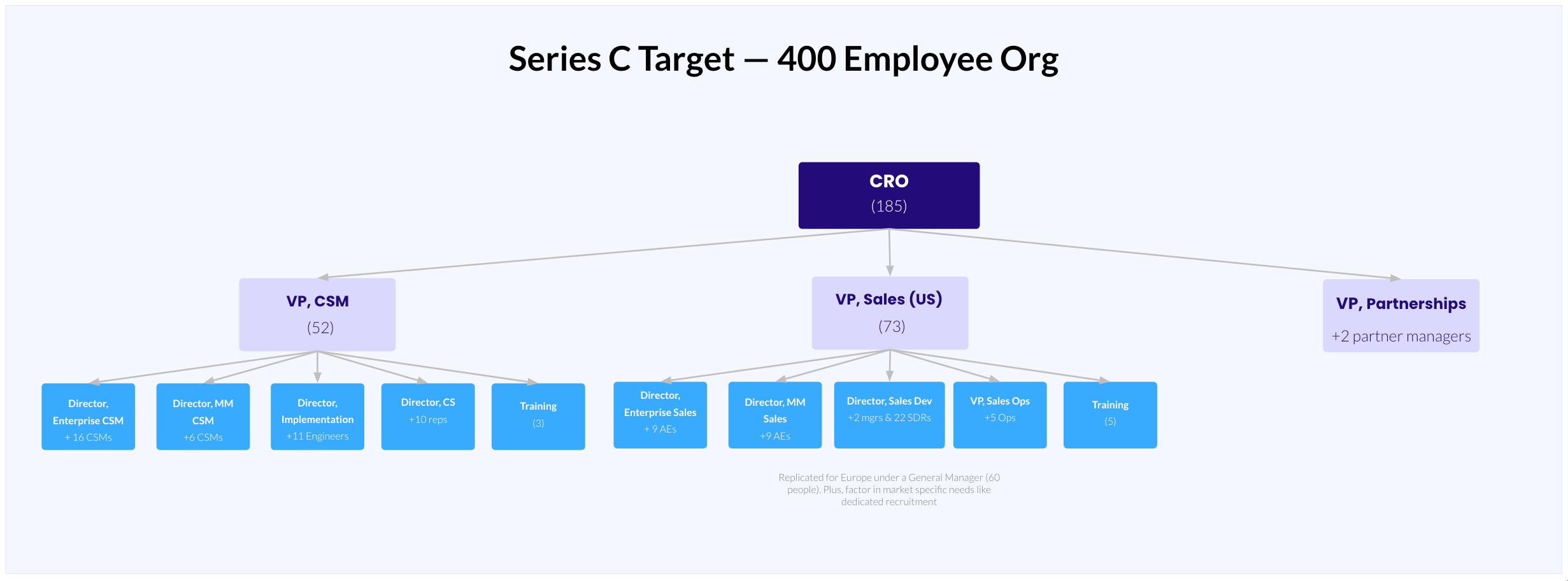
Opportunities for collaboration between SDRs and account executives should be taken wherever possible. Team selling lets everyone learn from each other, and can create closer working relationships - especially important if you’re managing a remote sales team.
Team-ups are also a great way to improve the sales experience. It can be really effective to pair a relationship specialist with a sales engineer or more technically-minded account executive, in order to both build the relationship and inform the client as much as possible.
For managers, getting on the call can be a great way to gather qualitative feedback for your team members, rather than appraising their performance solely through metrics. It can also be a great way to multi-thread, where the sales manager or director helps to build relationships up to the c-suite level.
5. Keep Track of Performance With Sales Metrics
Which metrics will tell you what you need to know?
It’s important to use a varied spread of sales metrics to assess and optimize both team and individual performance. Categorizing your metrics according to their stage in the SaaS sales cycle will help you more easily identify any blind spots in your sales analysis.
Top of Funnel Metrics
These are typically useful to gauge the success of your handoff between marketing and sales.
| Metric | Summary |
|---|---|
Lead Velocity Rate | Measuring increases or decreases in lead generation, month over month, allows you to forecast your future growth, goals, and milestones. |
Sales Qualified Leads (SQL) | Avoid chasing unsuitable leads by creating a solid benchmark to qualify new customers, based on budget, authority to purchase, business needs, etc. |
Marketing Qualified Leads (MQL) | A common metric tracked by marketing teams because pre-qualifying leads cuts down on wasted time for SDRs. But be careful, often teams and leaders over-index on the importance of this metric, as it can at times be too top of funnel to be an accurate predictor of revenue. |
Cost Per Lead | This is calculated by dividing the total marketing spend by the number of leads generated during the given period. A more granular approach uses Cost Per MQL/SQL to assess the effectiveness of each stage of the qualification process (as well as your marketing strategies). |
Middle of Funnel Metrics
High-quality data is integral to managing this tricky stage where most lost deals happen, typically between demo and deal closing. In addition to the metrics listed, Qwilr’s sales analytics can track buyer engagement to provide insights into how effectively your sales collateral is performing during this stage.
| Metric | Summary |
|---|---|
Win Rate | It’s important to know how successful your teams are at converting qualified opportunities into closed won revenue. Although be mindful to always pair this metric with a ‘volume’ indicator – a high win rate isn’t as exciting if you’re only closing a handful of deals each month. |
Customer Acquisition Cost (CAC) | Tracking the cost of each closed deal allows you to choose either investment or cost-cutting strategies according to your business needs. |
Revenue Per Lead/SQL | This metric, combined with conversion rate, provides a useful measure of how effectively your teams are producing revenue from pipeline. You can use fluctuations in this metric to figure out how many leads each rep should be realistically chasing without dropping the quality of their work. |
Bottom of Funnel Metrics
These provide useful data on both the quality of your sales, customer success and support functions, and more broadly, whether your product successfully solves your customer’s problem.
| Metric | Summary |
|---|---|
Expansion Revenue | This metric helps you understand how much additional revenue is being generated from acquired customers. It includes up-sells and cross-sells. High expansion revenue indicates that your customers are finding value in your product and are willing to invest more in your offering. It is calculated by subtracting the revenue at the beginning of a period from the revenue at the end of the period, then dividing by the revenue at the start of the period. A positive percentage indicates growth and is important metric investors look for when funding companies. |
Churn Rate | Divide the number of lost customers by the number of customers you started with during a given time period. If the number is negative, that’s a good sign - you’ve increased your overall number of customers. |
Net Promoter Score (NPS) | This metric is used to measure the likelihood your customer will ‘promote’ you and recommend you to others. The data should be drawn from a customer satisfaction survey or similar sources. As a general rule, nine or 10 out of 10 should categorize a customer as a promoter. Below 6, and they’re unlikely to say good things about you - these are ‘detractors’. Subtract the percentage of detractors from the percentage of promoters - the higher the resulting figure, the better. |
By measuring your results in detail, you can select your strategies to suit the strengths and improve the weaknesses of your team and your product.
6. Five Winning SaaS Sales Strategy Tactics
These tried and tested tactics have formed the backbone of the most successful B2B SaaS sales strategies across every vertical.
Sales Technique #1: Free Trials
Giving customers the chance to ‘try before they buy’ is a time-honored sales tactic that’s particularly well-suited to SaaS’s relatively low operational costs and complex products.
A shorter trial of seven or 14 days has been demonstrated to be more cost-effective - reducing the length of the sale cycle, and amplifying the buyer’s urgency to make the most of the limited time span. However, more complex SaaS products designed for enterprise saas sales models may require a longer testing period, to allow multiple stakeholders to experience the product’s benefits.
A related strategy is the ‘freemium’ model, where users are granted permanent access to a limited version of the product. It doesn’t work for every SaaS business, though - here at Qwilr, we moved away from using a freemium strategy (and here’s why).
Sales Technique #2: Annual Pricing (and Other Pricing Tactics)
By offering customers the opportunity to pay for a longer term in advance (a year or more instead of a monthly subscription), SaaS companies can gain the following advantages;
- Longer contracts are proven to reduce churn rate, in comparison to monthly subscription pricing models. A longer contract period can also provide an additional degree of immunity from efficiency initiatives, as the product’s position is ‘safe’ for the contract length.
- The predictable cash flow generated by lump-sum annual payments can underpin more ambitious investment and growth strategies.
- The improved retention increases the average Lifetime Value (LTV) of each customer. This benefit can be shared with the customer, by offering a lower price point on annual contracts compared to monthly subscriptions.
- Your upselling and cross-selling strategies will be more welcome to customers on longer-term contracts - if they’re continually reminded of your fees by the monthly invoice, they’re probably less likely to tolerate the idea of giving you more money.
Sales Technique #3: Customer-Centric SaaS Sales Processes
As much a mindset as a sales plan, successful SaaS sales teams put the needs and wants of their customers at the center of every stage, process, and interaction in the sales cycle. In the same way we categorized metrics, nurture points should also be divided into early, middle, and end-stage tactics for measurement and assessment purposes.
Research your leads to explore the best ways to add value. Use company websites and social media, personnel LinkedIn profiles, and 3rd party research tools like Apollo.io to find out how you can;
- Save them money
- Save them time
- Reduce their risks
- Increase their revenue
Stay in touch, and utilize feedback. There’s definitely a balance to be struck - too many touch points, and you risk pestering the client. But for qualified leads, it’s important to follow up regularly, and demonstrate to your customers that you value the relationship.
Avoid your communications becoming stale and monotonous by using a variety of sales channels and techniques - for example, embedding ‘trigger events’ in the free trial product. This lets you provide targeted assistance via email or chatbot when the user accesses a feature for the first time.
Ask lots of questions, and then leverage the feedback – implement changes based on what you learn about customer preferences, and make sure you let them know that you’ve acted on their advice.
Sales Technique #4: Upselling and Cross-Selling
This selling strategy works hand-in-hand with your pricing strategy, especially for SaaS businesses using multiple product tiers, where advantages of higher-tiered products or add-ons become more valuable to customers as they scale up.
It’s essential to tailor your upselling and cross-selling efforts to match the needs of the client - the better your understanding of their use of the product, the easier and more useful your recommendations will be.
A related selling strategy is co-marketing, where you’ll recommend other companies’ products that work well with your own (on the understanding that the other company does the same). This can be a great way to generate additional leads and sales, while adding value for the customer.
Sales Technique #5: Demonstrations
Delivering product demos is an art form, but it’s easy for confident reps to get carried away with the sound of their own voice.
Avoid ‘product-first’ thinking, and don’t try to show off every single feature. Instead, take typical workflows and use cases that are relevant to your customer, and then demonstrate how the product operates as simply and clearly as you can.
Emphasize benefits over features whenever possible, leave time and space for the customer to react and absorb the information, and create a set of useful prompts to get them to ask questions.
7. Common Tools That Support an Effective SaaS Sales Strategy
The right combination of the best SaaS sales tools can significantly enhance or hinder your sales strategy. When done right, effective tooling can help aid lead management, proposal creation, meeting facilitation, performance management and more.
Here’s a rundown of essential tools common in high performing sales teams:
1. Customer Relationship Management (CRM) Software
CRM software is vital for managing leads, tracking interactions, and consolidating all relevant information about your prospects in one centralized location.
This not only aids in organization but also enables a tailored approach based on the prospect's interaction history with your team.
Popular CRM platforms like Salesforce, HubSpot, and Zoho provide comprehensive solutions for managing customer information, improving communication, and streamlining sales processes.
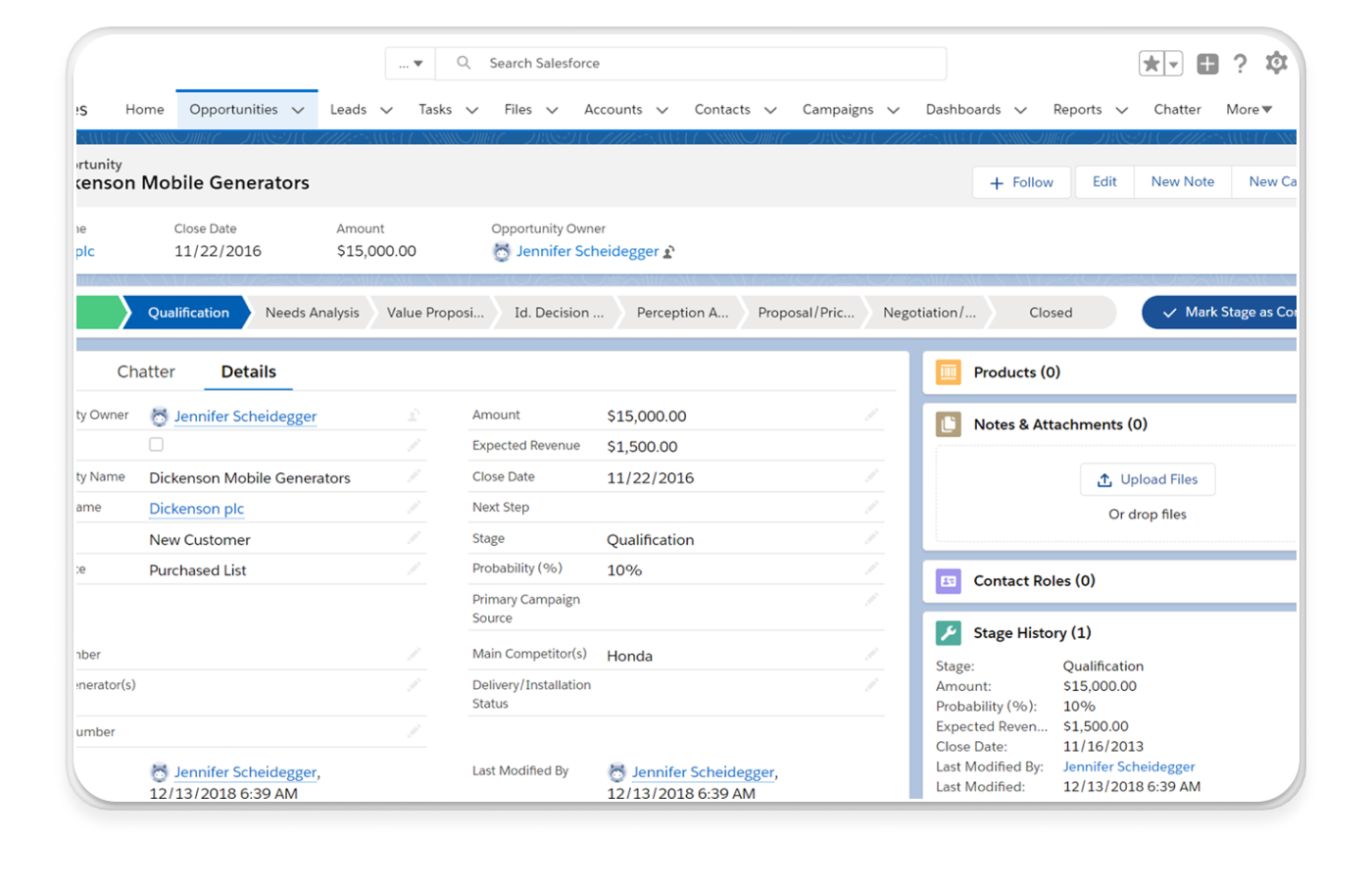
2. Sales Enablement and Proposal Software
Sales enablement tools, including proposal software, are crucial for accelerating the sales cycle. Tools like Qwilr enable you to craft interactive and aesthetically pleasing proposals, enhancing professionalism and efficiency. They offer professionally designed templates, customization options, and features like eSignatures to streamline proposal creation.
Qwilr's software also gives you a head start with an SaaS proposal template
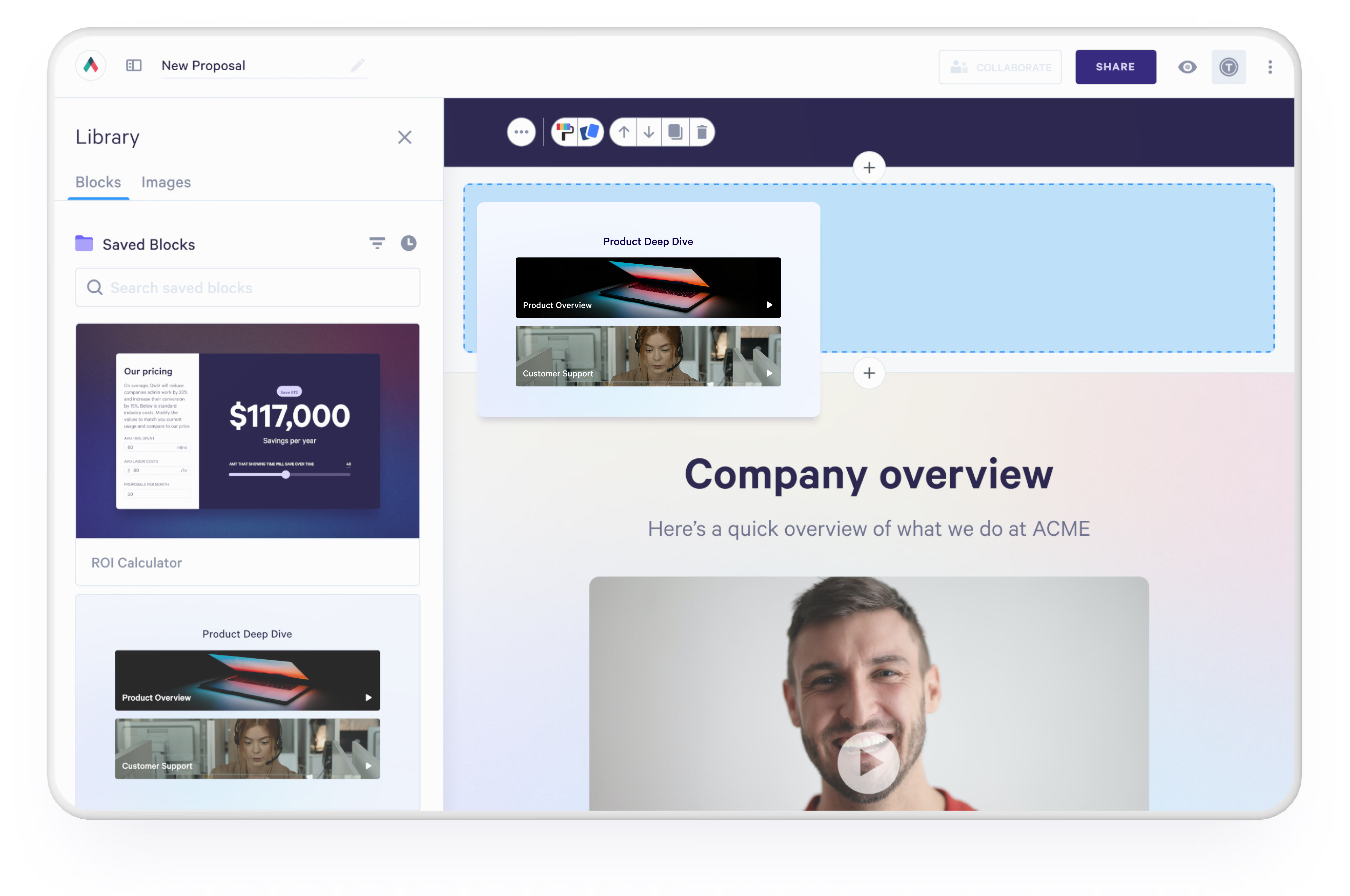
You can also check our guide on other top-rated sales enablement software.
3. Video Conferencing Software
In the realm of SaaS, where products are digital, and clients can be global, the importance of reliable video conferencing cannot be overstated as essential remote sales software.
Platforms like Zoom, Microsoft Teams, or Google Meet facilitate virtual meetings, demos, and collaborative sessions, which are essential for engaging with prospects and clients in a more personal and interactive manner.

4. Appointment Scheduling Software
Efficient scheduling tools like Calendly or Acuity Scheduling simplify the process of arranging meetings with prospects and clients. These tools integrate with your calendar, allowing prospects to book meetings based on your availability, thus reducing the back-and-forth emails and streamlining the process of connecting with potential clients.
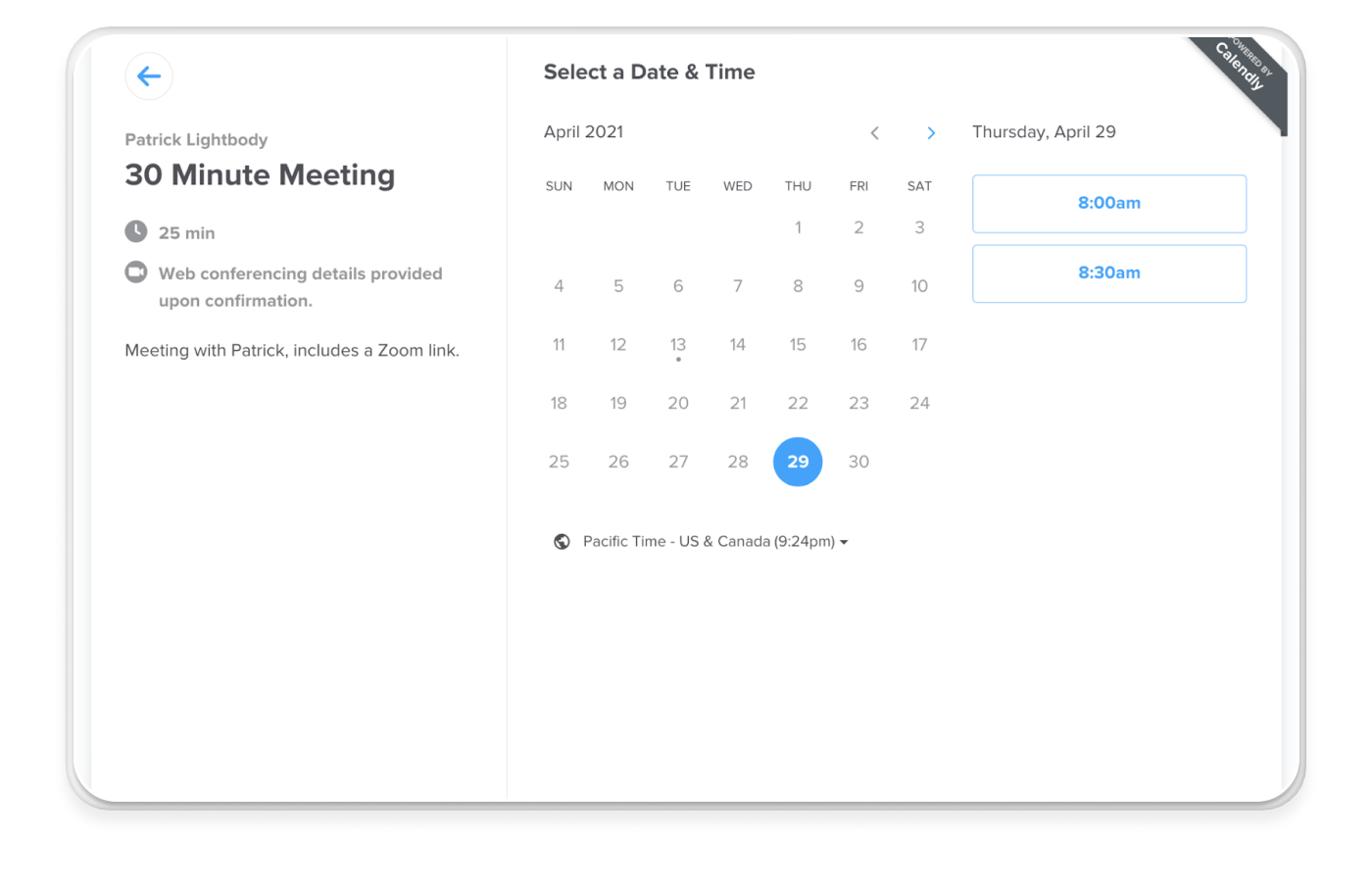
5. Sales Analytics and Performance Measurement Tools
Sales analytics platforms are crucial for understanding customer behavior, tracking sales performance, and refining your sales strategy. Tools like Tableau or Looker provide deep insights into sales data, helping you make informed decisions and adjust strategies based on real-time performance metrics.
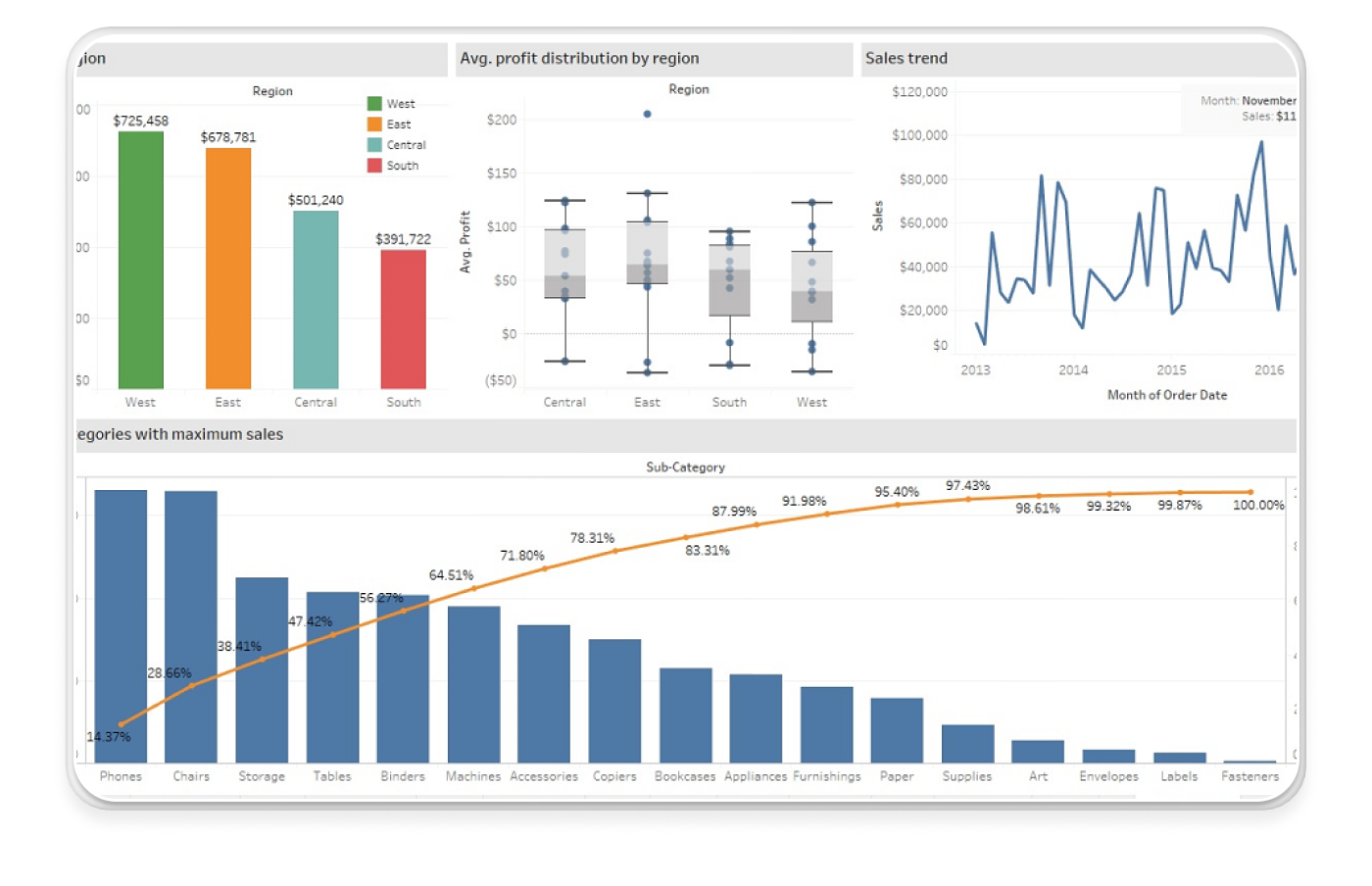
Final Thoughts
SaaS sales strategies aren’t just a set of tools you can bolt-on to your business and expect results. The best SaaS companies put the emphasis on providing value, understanding the needs of their customers, and creating a great sales experience. The sales strategies they use are dictated by these factors – and their sales teams are successful mainly due to these strong foundations, rather than any one strategy or tactic.
If your company’s sales experience is starting to feel like disjointed guesswork, it’s time to take a look at Qwilr. With Qwilr, you can create web-based collateral that delivers a better buyer experience and streamlines your sales process internally.
About the author

Dan Lever|Brand Consultant and Copywriter
Dan Lever is an experienced brand consultant and copywriter. He brings over 7 years experience in marketing and sales development, across a range of industries including B2B SaaS, third sector and higher education.
FAQs
A SaaS sales strategy is a method (or group of methods) used to increase sales and revenue for Software-as-a-Service products. As a SaaS company, your saas sales strategies should be chosen according to the needs of your customers, and the SaaS sales model that best fits your business.
Creating a SaaS sales strategy should be a five-step process.
- Choose a SaaS sales model (self-service, transactional, or enterprise)
- Identify your USP and customer avatar
- Create your sales playbook
- Effectively structure your sales team
- Track your sales metrics and adjust your strategy accordingly
A methodical approach will allow you to create the most effective SaaS selling strategy enabling you to ultimately bring in more revenue.
Crafting a sales strategy for a SaaS startup involves a few key steps.
- Start by understanding your target market: know who your customers are and what they want.
- Define your sales process clearly: from lead generation to closing the deal. Remember, in SaaS, it's all about demonstrating value, so make sure your process includes effective product demos or free trials.
- You'll also need a plan for customer retention – think onboarding, customer success, and regular check-ins.
- Keep refining your strategy based on data and feedback.
Finally, a SaaS sales strategy isn't a one-and-done deal – it's a dynamic plan that evolves with your business.


